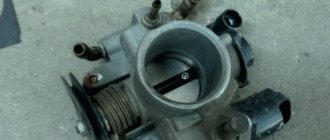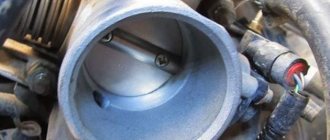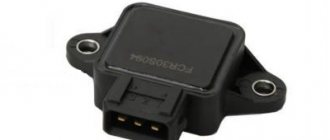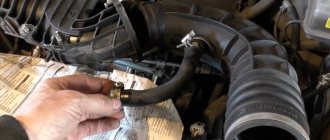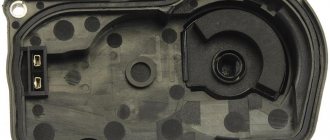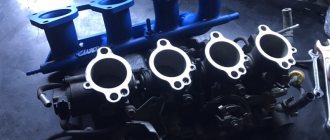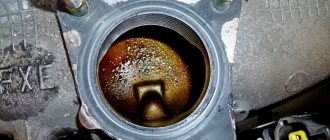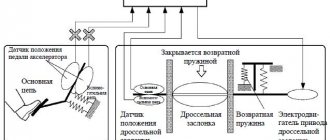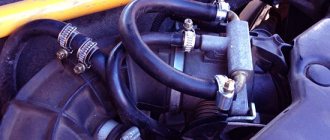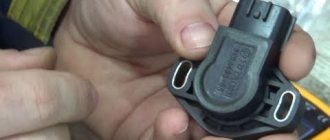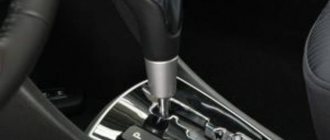An analogue of a modern car is a device made up of many components and assemblies. Deviations in the operation of the smallest component can lead to quite serious problems. The throttle position sensor (TPS) is one example of this type of component. And adjusting the throttle valve is an integral element of routine diagnostics of any car.
The throttle valve is presented in the form of an air valve, the functional task of which is to regulate the amount of air entering the engine. The fundamental features of the unit include a change in the cross-section of the air channel. When it is open, air flows smoothly through the intake manifold. The throttle position sensor, located here, determines the opening angle. This function is carried out through its communication with the engine control unit. The signals coming from the sensor contribute to the issuance of a command from the control unit to increase the amount of injected combustible mixture. Thus, the working mixture is enriched, and the engine operates closer to maximum speed.
Its sensor includes two types of resistors:
- Single-turn constant.
- Variable.
The sum of their resistance is approximately 8 kOhm. The reference voltage here is supplied to one of the outer terminals from the controller, and the second terminal is connected to ground. Thanks to this, a signal is sent to the controller, informing about the current position of the throttle valve. The value of the pulse voltage depends on the position level of the element, the standard interval of which is 0.7 to 4 W.
Important: the open state of the unit indicates the pressure level in the intake system of the vehicle is similar to atmospheric pressure; when closed, this value decreases to the vacuum state.
Throttle position sensor
The car throttle position sensor itself is located in/on the throttle assembly and is popularly called the “right foot sensor”.
It measures the opening value of the throttle valve and transmits this data to the engine control unit.
This sensor is potentiometric type, i.e. works on the principle of a conventional variable resistor. We most often find variable resistors in volume controls of audio equipment and in many other parts of our everyday life.
There is an opinion that the throttle position sensor is almost the most important metering element in the engine control system and the load on the engine is calculated from its signal.
Let's be clear. This must be understood to correctly diagnose the car.
We have already mentioned in the article Lean mixture that an internal combustion engine runs on air with the addition of a small mass of fuel. We also realized that the main dosing factor is air flow!
Air flow is the main and starting factor for all subsequent actions taken by the ECU in the process of engine control.
From this we can correctly conclude that the throttle position sensor is not the main metering device.
You can turn it off and the car won’t be too upset about it, but will go on without any problems from point A to point B or C or D. In general, it will go where it needs to go.
The entire load on the engine will be based on data from the air flow measurement sensors.
And we control the mass of this very air by physically opening/closing the throttle valve.
Throttle position (DZ position)
Despite all of the above, measuring the throttle position plays, although not the main, but very important role in the process of engine control. It helps you manage processes more accurately.
For example, an engine operating mode such as forced idling or cut-off mode (engine braking). The throttle position helps the ECU assess the situation and enable this mode.
Let's say the car speed is 55 km/h and the engine speed is 2600 rpm. We release the accelerator pedal, the throttle position becomes minimal, the ECU sees this and turns on the cut-off mode, turning off the fuel supply through the injectors. This allows you to use engine braking more effectively, increasing safety and extending the service life of the braking system, as well as saving fuel and significantly reducing the emission of harmful substances into our atmosphere.
But I’m lying if I don’t say that the ECU will already see that we have closed the damper due to a sharp drop in pressure in the intake manifold (with a DBP system) or a sharp decrease in the mass of air consumed (with a mass air flow sensor system). As we can see, in this case too, measuring the throttle position only helps to more accurately determine the cutoff or engine braking factor.
Throttle position at idle speed
What should be the readings of the DS position at idle speed?
Different! Why?
This parameter is more relevant to ardent fanatics of cleaning the throttle valve every week, or even every other day.
There are two main ways to control idle speed using the IAC (idle speed controller). Just control the speed xx! And don’t maintain the speed xx! It is very important!
So here it is:
- Using the idle speed controller installed in the bypass channel
- Using an idle air control that directly controls the throttle valve
Both systems are found on different cars. Even the Chevrolet Lacetti uses a different way to adjust the idle speed. On 1.4L and 1.6L engines the second method is used, and on 1.8 engines the first method is used.
This parameter in diagnostics is called “IAC Steps” or “DZ Position Step”. We will look at this in more detail in one of the future articles, but now I will briefly explain what the fundamental difference between these two methods is. This is necessary to understand throttle position diagnostics.
As we already know, all processes in the engine begin with air supply. By supplying air, we can regulate engine speed in different modes. The same thing happens when adjusting the idle speed. By supplying a certain mass of air, we regulate the speed xx within the required limits.
Note! The idle speed regulator performs a rough adjustment of the idle speed (about +/- 50 rpm. After this, the idle speed is more precisely regulated by changing the speed limit. But this is the topic of another article and now it is not so important.
So, in the first case, the damper is completely closed, and the air required for idling is supplied bypassing the throttle valve through a special channel. This channel contains a special valve-regulator that regulates the mass of air passing through this channel.
And in the second case, the air supply is carried out through the throttle valve itself. The damper is opened/closed using an electric motor and the necessary air mass passes through it to allow the engine to idle.
That is, it is obvious that in the first case, when the engine is running in idle mode, the correct values of the DS position will be equal to zero! Since the air does not flow through the throttle valve, but through a special IAC channel.
And in the second case, when the engine is idling, the correct values of the DS position will be equal to several percent (degrees). The readings cannot be zero, because if the damper closes completely, then the engine will stall.
We already have our first conclusion. That's the essence of it.
To properly diagnose throttle position, the first step is to determine how the idle speed is adjusted on that particular vehicle. If according to the first method, then the position of the DS at idle should be equal to 0%! And if using the second method - then a few percent!
Note: There are exceptions in all areas of our lives. Here too. For example, the Lacetti 1.8 LDA with the MR-140 control unit, although it has a separate idle speed regulator, but the throttle position at idle is 10-12%
In the first case, everything is simple and clear. If the values are different from zero, it means either the throttle valve cannot close tightly due to dirt or something else, or the throttle position sensor is not showing the truth, which means it is worn out and broken.
But in the second case, not everything is so simple.
There is an opinion that if the opening of the shutter is more than 5%, then mandatory cleaning of this very damper is necessary. This is true, but with many nuances.
And the most important of them are those that we have already talked about above:
- The idle speed regulator does not maintain idle speed, but regulates it
- The load on the engine is calculated by air flow (manifold pressure). The greater the mass of air consumed, the greater the load. Conversely, the greater the load on the engine, the more air it needs.
Problems with the DAAZ 2107 carburetor
Despite the fact that the device is reliable and durable, units that are more than 30 years old are also in use today. During such a period of use, the likelihood that the car owner will encounter various kinds of problems is quite high.
What malfunctions are typical for Dimitrovgrad-made carburetors:
The engine stalls when you press the gas
At the moment of start or when idling, the power unit may stall when the driver smoothly presses the pedal.
Why does this happen:
- The holes in the transition system of chamber 1 may become clogged. They need to be blown out or treated with a cleaner.
- The accelerator pump is broken. It is replaced or repaired.
It is also possible that when moving while gas is supplied, the engine jerks and may stop. To prevent this, you urgently need to press the pedal again.
What does this mean:
- The channels, jets or emulsion well are clogged. The defect can be eliminated by cleaning the elements.
- The nozzle of the dosing system of chamber 1 is not screwed in completely. It needs to be wrapped.
- The jets are not selected correctly.
- The fuel level in the float chamber is insufficient, which is regulated by setting the float and valve.
- The filter installed at the inlet is dirty. It needs to be dismantled and cleaned.
- Poor condition of sealing elements that need to be replaced.
The ignition system may also be faulty.
Pouring gasoline
This problem is encountered quite often. Usually it lies in a malfunction of the metering units or the vehicle’s fuel system.
- malfunction or leakage of the needle valve;
- leakage or breakdown of the float;
- the float touches the walls when moving around the chamber;
- the fuel level in the float chamber is exceeded;
- the jets supplying air are clogged;
- fuel pump failure.
Knowing the design of the carburetor, it is not difficult to find the source of the problem.
Shoots
The power unit may shoot into the carburetor. Such pops can be heard both at start and when moving at speed. This leads to high fuel consumption, engine overheating, unstable idling, and also to the fact that the engine cannot develop full power. Shooting indicates improper adjustment of the fuel-air mixture preparation and gas distribution system.
Gasoline is not supplied
If fuel does not flow into the carburetor, there can be many reasons.
Main sources of problems:
- fuel filter contamination;
- ice formation in the gas pipeline;
- leaks at fuel line connections;
- interference in the hose that comes from the gas tank;
- fuel pump failure;
- contamination of the carburetor filter element.
The second camera does not work
In carburetors with two chambers, it is possible to increase the efficiency of the power unit while maintaining excellent power parameters. However, the 2nd compartment often fails.
The malfunction may be related to:
- flooding due to contamination of fuel channels;
- incorrect clearance settings;
- malfunction of the throttle valve drive;
- poor condition of the pneumatic drive diaphragm;
failure of any elements: jets, diffuser, economizer XX, etc.
Accelerator pump does not work
Problems in the functioning of this unit lead to the fact that gasoline does not flow or is supplied under the wrong pressure, resulting in difficulties with acceleration. As a rule, the reason for the lack of fuel supply is a clogged fuel nozzle of the accelerator unit or a ball sticking to the check valve bushing
If the jet does not have enough pressure, you should pay attention to the condition of the ball and its position, as well as the leakage of the diaphragm connection, which is located between the top cover and the body. To fix the problem, you need to clean the components and evaluate their condition.
High throttle position
Very often you have to answer the same questions. The most important of them is this: “I cleaned the throttle valve, but its throttle position readings do not change and are 5-7%. Is the throttle assembly worn out?
Let me give you an example from life. The person was very puzzled by the inflated readings of the remote control position, which were about 7-9% at idle. Having read a lot of forums on the Internet and sites called “Pishulishbypisit”, I started ripping out the throttle assembly. I washed it - it didn't help. It means you didn't wash it well. I washed it again and very thoroughly. It didn't help again. What can I do? It’s already shiny, like something on a cat’s, but still according to the indications it’s dirty!
Then his puzzlement grew into a more drastic phase - probably the damper was jammed and not closing.
It’s good that at least I didn’t have time to disassemble the throttle assembly in search of a jam.
A timely, careful diagnosis revealed the cause of his sleepless nights.
The culprit turned out to be... the generator.
It only took one look at the accessory belt to know something was wrong.
It turned out that the generator rotor was spinning so hard that the engine did not have enough standard idle power to rotate it. And, naturally, the ECU opened the throttle valve slightly to allow more air to enter.
Like this. But the throttle is now very clean
From this we have already come up with the second rule. That's the essence of it.
If the values in the “drone position” parameter are too high, this does not necessarily mean that you need to drop everything and run with bulging eyes to clean the throttle valve.
If you are interested, you can check this fact yourself. Start the engine, connect the diagnostic adapter, press the brake and try to move away without pressing the accelerator pedal. Pay attention to the position of the throttle valve. As the load on the engine increases, the DS position readings will also increase. The ECU will automatically open the throttle to increase power and maintain the required idle speed within the specified limits, even under load.
Also, the ECU itself controls the position of the remote control when starting and warming up the engine, opening and closing it slightly depending on the engine warming up and the ambient temperature.
Therefore, we can draw conclusions why the throttle position on the Lacetti 1.4/1.6 and similar cars may be too high:
- The throttle assembly is dirty and the throttle valve does not close to the required values. Needs cleaning.
- An increased load is applied to the engine and the ECU purposefully increases the percentage of opening of the throttle body in order to ensure that the engine can idle. This requires comprehensive diagnostics of the engine and attachments.
How to adjust the throttle valve drive of a Gazelle car
Disconnect the negative terminal of the battery.
Use a screwdriver to loosen the screw, remove the clamp and rubber air duct from the throttle body.
Use a 10mm wrench to loosen the cable lock nut on the sector.
From the side of sector 3 of the throttle valve, you need to pull out cable 1 until it stops.
The upper lever 5 of the accelerator pedal should rest against the buffer 4 on the bracket.
Tighten nut 2 securing the cable to the sector.
In this case, the throttle valve must be completely closed.
Loosen the tightening of nut “A” and move the limiter “B” of the pedal lever until it stops in the pedal bracket. Tighten nut “A”.
If we fully press the gas pedal, the throttle should be fully open, and the lower lever of the pedal should rest against the mat
You can correct the position of the cable by moving the tip 1 of the shell in the bracket, loosening the tightening of the nuts 2.
After adjusting, tighten nuts 2.
If necessary, repeat the adjustment. Once the adjustment is complete, replace the air duct.
Checking and adjusting the throttle drive cable on the ZMZ-4025, ZMZ-4026, ZMZ-4061, ZMZ-4063 engines
Press the gas pedal all the way into the mat and hold or fix it in this position by inserting a suitable wooden block.
Unscrew nut 1 two to three turns and turn sector 2 of the throttle valve drive all the way so that the valves are completely open.
Pull the cable and tighten nut 1.
Let's release the gas pedal.
The throttle valves must close completely, the sector must reach the stop.
If this does not happen, adjust the position of sector 2 by moving tip 3 using nuts 4.
Loosen the tightening of nut “A” and move the limiter “B” of the pedal lever until it stops against the pedal bracket. Tighten nut “A”.
We check the correctness of the adjustment.
We press the gas pedal all the way, while the throttle valves should open completely, and the throttle sector should reach the stop.
We release the pedal - the dampers should close completely, and the sector should reach the stop.
Low throttle position
Let's go back to cleaning the throttle body and set the record straight.
We often see this kind of rating of clean dampers.
People are really happy when, after cleaning (or not cleaning) the throttle valve, the readings of the throttle valve position are less than those of the loser who didn’t clean it well. He got 2.5%, but I got as much as 0.8%! Simply cool!
Should we be happy about such a low throttle position?
Again, not to be unfounded, let's conduct an experiment.
Let's take as a basis our well-known fact that for certain engine operating parameters a certain mass of air is required.
We connect the adapter for car diagnostics and start the engine at idle speed. We look at the parameter “DZ position”
The throttle position (opening) is 2.4%. The position of the idle air control (STEP) is 24
Disconnect any hose from the intake manifold. For example, a short hose from the crankcase ventilation system valve
This will ensure that excess air is sucked into the intake manifold.
Now let's look at the throttle position readings
The value of the remote sensing position became 0.8%! What a cool way to clean the throttle valve without even getting your hands dirty
And the position of the IAC became only 5 steps.
Is it clear what happened?
The mass of air entering through the disconnected hose is almost enough to keep the engine idling, so to prevent the speed from increasing above the required speed, the ECU closed the throttle valve.
Therefore, you should not rejoice at small throttle position values on cars with idle speed control using remote control!
There are two main reasons for low throttle position on Lacetti 1.4/1.6 and similar cars:
- Air leak into the intake manifold. This also reduces the idle speed control steps.
- The cable from the gas pedal to the throttle valve is not adjusted correctly. In this case, the idle speed control steps do not decrease, but remain normal.
I talk about this in more detail in the video at the end of this article. Be sure to watch it if your car has a low DS position.
Adjusting the engine damper sensor 1JZ
If, for example, you have a car with a 1JZ engine without VVTi, then it is regulated as follows:
We remove the throttle itself, remove the remote control sensor, adjust the damper with a stop screw so that when closing there remains a barely noticeable gap (it can be seen if you look at the light bulb through the remote control). We install the damper sensor and rotate it back and forth to such a position that when a 0.50 mm probe is placed under the thrust bolt, there is conductivity on the two lower contacts of the sensor, and if there is a 0.40 mm probe, then there is no circuit.
Correct throttle position
From all of the above, it is necessary to draw a general conclusion about the correct position of the throttle valve.
For vehicles with an idle speed control system using an IAC installed in a separate bypass channel, bypassing the throttle valve:
- The DS position value should usually be 0%. Increased values indicate an obstacle to closing the damper (dirt, jamming, damage, etc.) or a malfunction of the throttle position sensor itself or its wiring.
For vehicles with an idle air control system by acting on the throttle itself:
- The throttle position should usually be 2-4% on a fully warmed up and fully operational engine, including the serviceability of all its auxiliary units (generator, power steering pump) and consumers turned off (air conditioning, headlights, heated rear window, etc.)! An overestimated throttle position may be caused by increased, for some reason, load on the engine, contamination of the throttle sensor, or a malfunction of the throttle valve or its wiring. Low throttle position readings can be caused by excess air being sucked in bypassing the throttle valve (very common!) or by improper adjustment of the throttle valve drive.
We will not consider checking the throttle position sensor in this article, since I described this in detail in the article How to check the TPS
Alternative replacement
Sometimes there are cars with parallel installation of 2 TPS. In a functional sense, such installation will not add any power, but if one unit fails, the second one will operate uninterruptedly. Therefore, the introduction of two TPS is carried out in order to increase the reliability of the module. These elements can be either non-contact type or sliding contact type. As an addition, this module design includes an emergency damper position, which operates thanks to a return spring mechanism.
